
A grenade launcher is a weapon that fires a specially designed, large-caliber projectile, often with an explosive, smoke, or gas warhead. Today, the term generally refers to a class of dedicated firearms firing unitary grenade cartridges. The most common type are man-portable, shoulder-fired weapons issued to individuals, although larger crew-served launchers are issued at higher levels of organization by military forces.

The M203 is a single-shot 40 mm under-barrel grenade launcher designed to attach to a rifle. It uses the same rounds as the older stand-alone M79 break-action grenade launcher, which utilizes the high-low propulsion system to keep recoil forces low. Quite versatile and compatible with many rifle models, the M203 was originally designed for the U.S. M16 and its carbine variant, the M4. The launcher can also be mounted onto a C7, a Canadian version of the M16 rifle; however, this requires the prior removal of the bottom handguard.

The Mk 19 grenade launcher is an American 40 mm belt-fed automatic grenade launcher that was first developed during the Vietnam War.

The AGS-17Plamya is a Soviet-designed automatic grenade launcher in service worldwide.

The XM307 Advanced Crew Served Weapon (ACSW) was a developmental 25 mm belt-fed automatic grenade launcher with programmable airburst capability. It is the result of the OCSW or Objective Crew Served Weapon project. It is lightweight and designed to be two-man portable, as well as vehicle mounted. The XM307 can kill or suppress enemy combatants out to 2,000 meters (2,187 yd), and destroy lightly armored vehicles, watercraft, and helicopters at 1,000 meters (1,094 yd). The project was canceled in 2007.

The United States Armed Forces has created a plethora of different types of 40 mm grenades in both the low-velocity 40×46 mm and high-velocity 40×53 mm calibers which uses what it calls a high-low propulsion system which keeps recoil forces within the boundaries of an infantry weapon. Presented on this page is a basic overview.
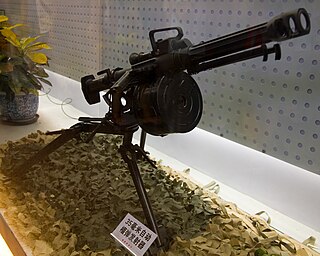
The QLZ-87 35×32mmSR automatic grenade launcher (AGL) is an air-cooled, gas operated fully automatic weapon and is crew transportable with limited amounts of ammunition. Unusual for handheld grenade launchers, the QLZ-87 fires high-velocity grenades of 35x32 mmSR caliber, which provides longer range and flatter firing trajectory.
ST Engineering Land Systems Ltd (STELS), formerly known as ST Kinetics, is a strategic business area of ST Engineering and handles land systems and specialty vehicles.
An automatic grenade launcher (AGL) or grenade machine gun is a grenade launcher that is capable of fully automatic fire, and is typically loaded with either an ammunition belt or magazine.

Denel Land Systems is a division of the Denel group.
The Neopup PAW-20 is a 20×42mm semi-automatic grenade launcher designed by Tony Neophytou and as of 2015, is produced and marketed by Denel.
The MEI Hellhound 40 mm low-velocity multi-purpose grenade is a fixed-type munition designed to be fired from a 40×46mm grenade launcher such as the M79, M203, M320, or Milkor MK-1. The round consists of an A5 filled metal projectile body with a rotating band, a point initiating-base detonating fuze with safe and arm technology, and a cartridge case assembly. Upon impact with the target, the firing pin is driven into the detonator, which in turn initiates the spit backcharge, producing a jet which initiates the explosive train from the base forward, resulting in an armor-piercing jet of molten metal and fragmentation of the projectile body. The MEI Hellhound uses the same high-low propulsion system as other popular 40 mm grenade launchers, which keeps the recoil forces in line with other infantry small arms.
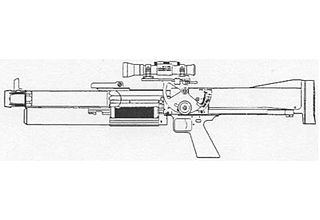
The EX 41 grenade launcher, also called the Shoulder-Fired Weapon (SFW), was a prototype multi-shot grenade launcher that was never adopted by the United States military. Most of its development was at Naval Ordnance Station Louisville for the US Marine Corps in order to replace the single-shot M203. NOS Louisville had previously developed the Mk 19 and Mk 20 multi-shot grenade launchers. The Picatinny Arsenal also aided in the EX 41's development as part of the Army's Bursting Munitions Technology program. In its final form, the EX 41 was intended to weigh as little as 6.8 kg and have a range of up to 1500 m. The program never progressed beyond a single prototype and in November 1995, the design was sent to Knight's Armament Company for further development.
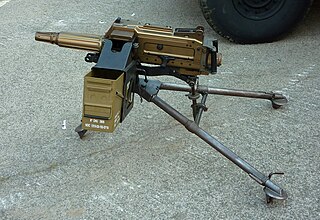
The SB-40 LAG is a 40 mm automatic grenade launcher developed and produced in Spain by the Empresa Nacional Santa Bárbara company.

The Milkor MGL is a lightweight 40 mm six-shot revolver-type grenade launcher developed and manufactured in South Africa by Milkor (Pty) Ltd. The MGL was demonstrated as a concept to the South African Defence Force (SADF) in 1981. The MGL was then officially accepted into service with the SADF as the Y2. After its introduction in 1983, the MGL was gradually adopted by the armed forces and law enforcement organizations of over 50 countries. Total production since 1983 has been more than 50,000 units.
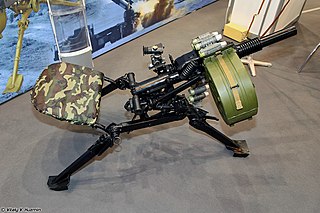
AGS‑40 Balkan is a Russian 40 mm caseless automatic grenade launcher and successor to AGS-17 and AGS-30, introduced and adopted by the Russian military.
The LG5 is a semi-automatic grenade launcher developed by Norinco and introduced in 2011. The launcher's designation "QLU" stands for "light weapon - grenade (Liúdàn) - sniper (Jūjī)" in Chinese military coding standard.
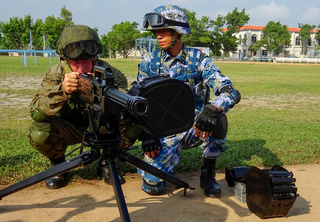
The Type 04 automatic grenade launcher is a Chinese 35x32SR mm belt-fed automatic grenade launcher, developed as an alternative to the older QLZ-87. It may be vehicle-mounted or crew-served.
The MK285 is an airburst grenade that can be fired from certain 40 mm belt-fed automatic grenade launchers.












